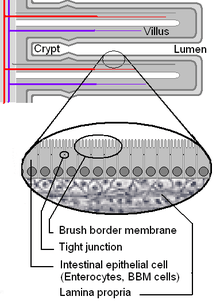Brush border

A brush border (striated border or brush border membrane) is the microvilli-covered surface of simple cuboidal epithelium and simple columnar epithelium cells found in certain locations of the body. Microvilli are approximately 100 nanometers in diameter and their length varies from approximately 100 to 2,000 nanometers in length. Because individual microvilli are so small and are tightly packed in the brush border, individual microvilli can only be resolved using electron microscopes;[1] with a light microscope they can usually only be seen collectively as a fuzzy fringe at the surface of the epithelium. This fuzzy appearance gave rise to the term brush border, as early anatomists noted that this structure appeared very much like the bristles of a paintbrush.
Brush border cells are found in the following main locations:
- The small intestine tract: This is where absorption takes place.[2][3][4] The brush borders of the intestinal lining are the site of terminal carbohydrate digestions. The microvilli that constitute the brush border have enzymes for this final part of digestion anchored into their apical plasma membrane as integral membrane proteins. These enzymes are found near to the transporters that will then allow absorption of the digested nutrients.
- The kidney: Here the brush border is useful in distinguishing the proximal tubule (which possesses the brush border) from the distal tubule (which does not).[5][6]
- The large intestine also has microvilli on the surface of its colonocytes (alternative name for enterocytes).
The brush border morphology increases a cell's surface area, a trait which is especially useful in absorptive cells. Cells that absorb substances need a large surface area in contact with the substance to be efficient.[7]
In intestinal cells, the microvilli are referred to as striated border and are protoplasmic extensions contrary to villi which are submucosal folds, while in the kidneys, microvilli are referred to as brush border.[8]
References
- ↑ Histology image:21901loa from Vaughan, Deborah (2002). A Learning System in Histology: CD-ROM and Guide. Oxford University Press. ISBN 978-0195151732.
- ↑ Histology image:12202loa from Vaughan, Deborah (2002). A Learning System in Histology: CD-ROM and Guide. Oxford University Press. ISBN 978-0195151732.
- ↑ Histology image:11703loa from Vaughan, Deborah (2002). A Learning System in Histology: CD-ROM and Guide. Oxford University Press. ISBN 978-0195151732.
- ↑ Basic Histology - Intestinal Columnar Epithelium
- ↑ Histology image: 35_19 at the University of Oklahoma Health Sciences Center - Kidney
- ↑ Histology at KUMC urinary-renal13 "Tubules"
- ↑ Southern Illinois School of Medicine: Specialized GI Cells
- ↑ Ross, Michael H. Histology : a text and atlas / Michael H. Ross, Wojech Pawlina., -5th ed. p 102.